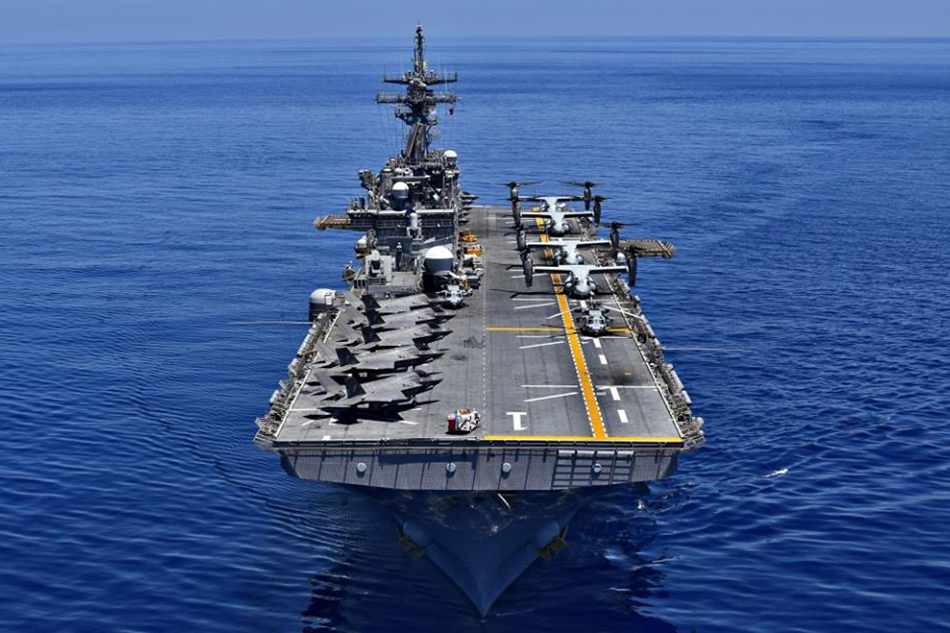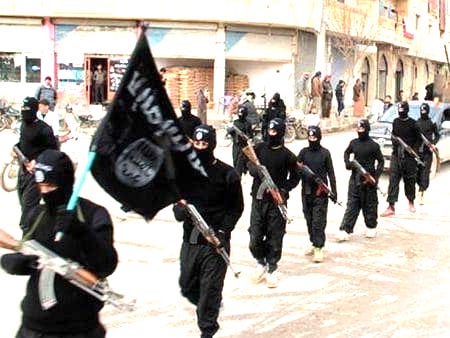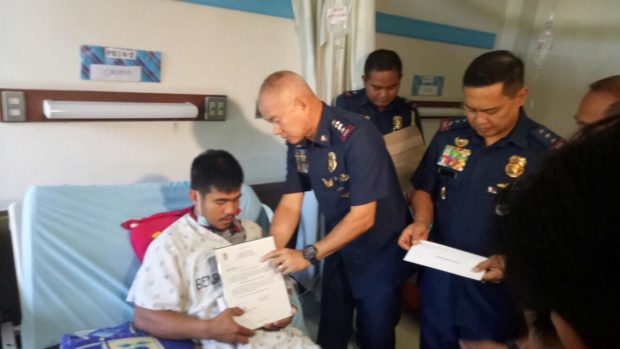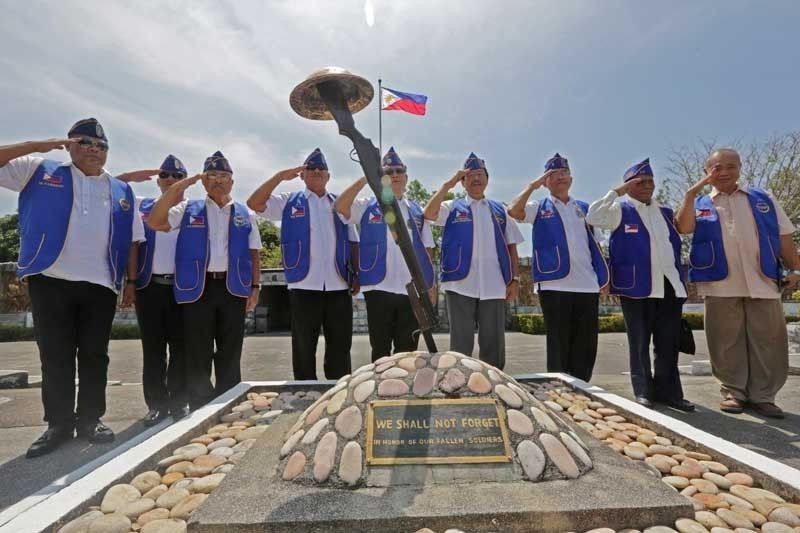Posted to the Lawfare blog (Apr 9, 2019):
Water Wars: Fear and Loathing in Manila (By Doug Stephens, IV)
 USS Wasp enters Subic Bay for the Balikatan 2019 joint exercises. (Photo credit: Mass Communication Specialist 3rd Class Benjamin F. Davella.)
USS Wasp enters Subic Bay for the Balikatan 2019 joint exercises. (Photo credit: Mass Communication Specialist 3rd Class Benjamin F. Davella.)Tensions around the contested island of Thitu (Tagalog: Pag-asa; Chinese: Zhongye) are escalating as China and the Philippines continue to press their claims. In March, the Asia Maritime Transparency Initiative (AMTI) and other observers
counted up to 275 Chinese vessels near Thitu, up from December’s high of 95. On April 1, the Philippines
registered an official protest against China’s Thitu presence, citing worries that what appear to be fishing boats are actually part of China’s maritime militia. The following day, Philippine President Rodrigo Duterte
delivered an address in which he implied an unwillingness to take military action, noting that Chinese missiles could reach Manila in “seven minutes” were war declared. Yet on April 4, the Philippine government
released a firm public statement on Thitu that included the unusually forceful claim that the Chinese presence is “illegal.” Chinese officials
responded swiftly, telling the Wall Street Journal later the same day that their ship movements are “beyond reproach.” Duterte
ended April 4 with a fiery speech at a rally in Puerto Princesa in which he told China not to touch Thitu: “If you make moves there ... I will tell my soldiers, ‘Prepare for suicide mission.’”
All of these events have taken place against the backdrop of
Balikatan 2019, a major annual U.S.-Philippines-Australian joint exercise scheduled for April 1-12 in Luzon and Palawan. Balikatan’s latest iteration
involves a combined total of 7,000 service members, as well as
deployment of the amphibious assault ship USS Wasp carrying an unusually heavy complement of F-35B fighters. U.S. weapons systems are moving all over the region, whether through joint exercise or sale. Singapore
announced in March that it is making a preliminary purchase of four F-35 jets from Lockheed-Martin as it begins the process of replacing its aging fleet of F-16s. And Vietnam
received six Metal Shark patrol boats from the United States on March 31, a gift worth approximately $12 million. One of the few places the United States has decided against sending materiel is the upcoming celebrations of the People’s Liberation Army (PLA) Navy’s 70th anniversary. The Trump administration has
rejected Beijing’s invitation to send several warships to participate in the ceremonies, citing worries that it could be seen as supporting the legitimacy of China’s maritime claims.
In Other NewsIn Diplomatic DevelopmentsCountries all over the region lodged diplomatic protests against China in late March. On March 21, Vietnam
protested the sinking of a Vietnamese fishing ship by a Chinese maritime surveillance vessel in the contested Paracel Islands. A day later, Vietnamese officials
complained about a series of Chinese live-fire exercises, also in the Paracels. On March 29, the Philippines
filed a protest regarding the increasing Chinese presence around Thitu. The following day, Taiwan
registered complaints with the press and regional partners about Chinese jet fighters crossing the centerline of the Taiwanese Strait that morning. Most dramatically, two former Philippine government officials have
sued Chinese President Xi Jinping in the International Criminal Court, arguing that his government’s actions in the South China Sea amount to crimes against humanity.
In a shift from their past silence, both the EU and NATO have begun acknowledging China’s potential threat to Atlantic stability. On March 12, the EU Commission
released a brief report describing China as a “systemic rival promoting alternative models of governance.” The commission proposed 10 actions for EU heads of state to discuss at their next conference. And NATO ministers have scheduled their first meeting on the topic of China for early April. The Wall Street Journal
cites several officials as saying that the meeting is driven by concerns about Chinese involvement in transport and data infrastructures around the world. Both bodies find themselves in the difficult position of articulating principled concerns even while many of their constituent countries have begun relying heavily on Chinese trade and investment.
The United States is
moving its de facto embassy in Taiwan to a new site in Taipei. On May 6, some 500 personnel attached to the American Institute in Taiwan (AIT) will set up shop in a new 16-acre campus in Taipei’s Neihu district. On April 3, AIT officials
confirmed for the first time that military service members have been stationed at its facilities since 2005 and that those deployments would continue.
Early in March, former Australian Prime Minister Malcolm Turnbull
weighed in on Australian-Chinese relations. In an address to the Henry Jackson Society (a foreign policy think tank headquartered in London), Turnbull emphasized a need to be wary of China’s geographic and technological endeavors but admitted that the militarization of the South China Sea is now an “irreversible” feature of the region.
In the AirJapan
scrambled fighter jets on March 20 to intercept two Chinese spy planes in the East China Sea. While the PLA Air Force aircraft did not ultimately cross into Japanese airspace, it was the second such incident this year and the sixth since October. The confrontation took place a week after China
reported a deadly fighter crash on Hainan province in the South China Sea that killed two pilots.
Hot on the heels of the announcement of U.S.
withdrawal from the Intermediate-Range Nuclear Forces (INF) Treaty, the U.S. Army is
seeking funds to prototype next-generation artillery, including a long-range strategic cannon and hypersonic missiles. Neither of these would have been barred under the INF Treaty, but both moves signal a renewed commitment to long-range strike capabilities in the Asia-Pacific theater.
On the GroundU.S. General Robert Brown, commander of Army forces in the Pacific, has
announceda significant expansion to the Pacific Pathways deployment program. Based on the new Dynamic Force Employment strategic program, these rotations would see up to 10,000 additional soldiers stationed in partner nations around the Pacific at any given point. Details on when this surge will take place have not been released. As part of the same focus on Pacific relationship-building, the U.S. military is
in talkswith the Federated States of Micronesia to open new naval and air facilities on their islands, as well as to conduct joint military exercises in their territory. Micronesia lies midway between Hawaii and the South China Sea, and Washington has long understood it as a vital U.S. strategic partner in the region.
The Philippines is seeking more infrastructure loans from China despite warnings from allies. Malaysian Prime Minister Mahathir Mohamad
addressed Duterte directly on March 7, saying that “you have to be very careful” owing money to the Chinese. U.S. Secretary of State Mike Pompeo
delivered a similar message on March 12. He characterized Chinese “debt traps” as “political transactions” rather than economic. Nevertheless, a Filipino delegation, headed by Executive Secretary Salvador Medialdea,
traveled to Beijing on March 19 seeking funding for construction of a new dam. The project promises to alleviate Manila’s severe water shortages. Philippine Supreme Court Justice Antonio Carpio
noted on March 22 that the credit arrangement for the Chico Dam project requires forfeiture of Filipino gas fields upon a default. But the Duterte administration
doubled down three days later, saying that seizure was “not possible” because default was so unlikely.
China made two announcements in March regarding future development of its island holdings in the South China Sea. The first and most significant revelation is that China
intends to turn Woody Island in the Paracel chain into an “island city.” Secretary Zhang Jun of the Paracel administration described the project in vague terms as development of a “key national strategic service and logistics base.” Then, on April 1, PLA Daily
relayed reports of a new kind of communications and sensor infrastructure platform designed for offshore and reef use. These platforms are claimed to be suitable for both scientific and state use but will have a special capacity for “defending … islands and reefs, and continuous monitoring of targeted waters.” China anticipates that in two to three years these waters will be
patrolled by a new, larger class of patrol vessel, the contract for the first of which was signed on March 26. Details are scarce on the proposed ship, but it is planned to have a displacement of 10,700 tons and measure 165 meters in length.
In the DeepThe Indo-Pacific submarine arms race remains in full swing. The 2019 edition of “The Military Balance” (
discussed here on the Lawfare Podcast)
estimates 280 full-size and miniature submarines in operation in the region. The South China Morning Post
reports on a series of calls for new operational rules that could prevent accidents or collisions in crowded waterways. The U.S. and China are both party to the 2014 Code for Unplanned Encounters at Sea (CUES), which provides rules to mitigate the risk of ship collisions and miscommunication, but as of this writing, there is no agreed-upon set of guidelines for managing underwater interactions.
The Global Times
reports on a new Chinese program that intends to build an underwater navigation system for deep-sea submarines. The system purports to be paired with China’s existing BeiDou satellite navigation framework and use sound waves to penetrate the ocean. An early demonstration area aims to cover approximately 250,000 square kilometers of the South China Sea. The system’s implications for foreign submarine activity are unclear.
The battle between Huawei and its loose coalition of detractors has
developed an undersea dimension as Chinese technology is being used in data cable projects around the world. Huawei Marine Networks, a subsidiary of Huawei Technologies, has participated in around 90 different undersea cable projects worldwide. U.S. regulators have little hard evidence to point to in defending their claims, but they maintain that Huawei’s very close relationship to the
hack-happy Chinese state renders its technology presumptively insecure. White House economic adviser Larry Kudlow
reported on April 3 that Chinese officials have conceded for the first time that the U.S. “ha[s] a point” regarding the cyber concerns.
AnalysisThe U.S. Navy released its
Cybersecurity Readiness Review on March 4. Commissioned in October in response to “significant compromises” of Navy systems, the review excoriates the current state of Navy cybersecurity and offers a new set of best practices. It concludes that cyberwar is both an “existential threat” to the Navy and Marine Corps, as well as an ongoing conflict that they are “losing.”
In the “Naval War College Review,” Andrew Erickson, Joshua Hickey and Henry Holst
analyze the composition and capabilities of China’s maritime law enforcement (MLE) forces, now easily the world’s largest. Incorporation of features such as helicopters, deck guns and interceptor craft into MLE vessels has given China the tools needed to assert influence through force without involving its formal warships.
Over at the Australian Strategic Policy Institute’s Strategist, Ankush Wagle offers
perspective on how the Andaman Sea is increasing in strategic importance. Once protected by the Thai peninsula from the scrum in the South China Sea, recent years have
seen Chinese submarine activity in the Andaman and a corresponding increase in Indian presence. Wagle argues that this region’s significance will only increase as Myanmar and Thailand accept Chinese investment.
The AMTI has
published a brief paper anticipating how a future Chinese claim to straight baselines around the Spratly Islands might interact with China’s larger goal of enclosing much of the South China Sea. The authors analyze four potential baseline-drawing methods and conclude that, while only two would extend Chinese claims beyond the nine-dash line, any of the four would seriously escalate tensions with Vietnam and the Philippines by transmuting merely contested areas into Chinese-claimed internal waters.
At Voice of America, Ralph Jennings
reports on a growing scholarly consensus that China’s land acquisition in the South China Sea is finished, at least for the time being. Questions remain, however, on whether this pause is because the current claims are sufficient to accomplish China’s final policy goals, or if this pause is merely the end of “stage one” in a longer program.
Finally, Premesha Saha
argues at the Observer Research Foundation that Indonesia’s new military base in the Natuna area of the South China Sea marks a turning point for Indonesia’s regional stance. Officials characterize it as primarily for deterrence of the Chinese, but Saha contends that Indonesia is positioning itself to become more than a “middle power” in the region.
[Doug Stephens IV is a joint JD/LLM student at Harvard Law School and the University of Cambridge. He holds a B.A. in English from Liberty University and a M.A. in English from James Madison University.]
https://www.lawfareblog.com/water-wars-fear-and-loathing-manila




























